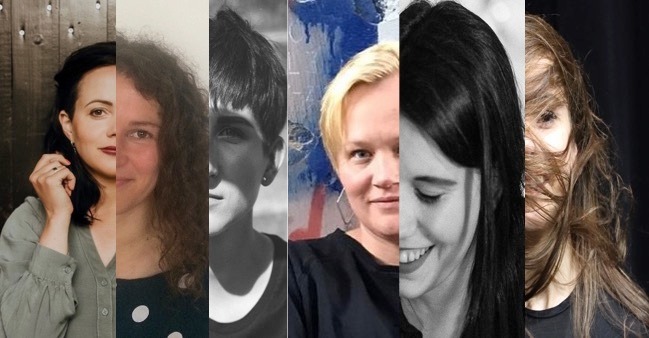Emerging local community of artists:
– Contemporary dance artist Agate Bankava, who is interested in collaborating in-depth with young people, exploring their relationship with the city and themselves in a specific place, emphasising young people’s thoughts, dreams and future plans;
– dramaturgy student Diāna Kondraša – she creates works in the aesthetics of documentary theatre with a deep interest and currently wants to cooperate with a representative of the Roma community;
– artist and curator Ieva Saulīte during the laboratory focused on conversations and research related to the elderly;
– theatre director Māra Gaņģe, wants to continue working with topics that have been of interest to her for a long time – the perception of the world and art by blind and partially sighted people and their current place in our society;
– theatre director Antra Leite’s deeply personal interest is in working with women who became mothers in 2020;
– for theatre artist and playwright Katrīna Dūka the main research area is LGBTQ+ community and cooperation with representatives of this community.
The laboratory cycle was led by artists that shared their experience:
– Krista Burāne, a documentary theatre and film director, playwright and author of interdisciplinary projects, who has implemented more than 20 art projects centered on the ‘everyday person’ various communities or ‘a very important and topical topic in society’;
– dramaturg, playwright, theatre artist and lecturer Jānis Balodis, who is a graduate of the DAS Theater master’s program in the Netherlands. Since 2011, Balodis has been the author and co-author of 17 performing arts projects focusing on documentary theatre and community work;
– in the laboratory, “Magic Carpets” residency participants and project implementers shared their experience in working with communities in 2019 and 2020: Ahilan Ratnamohan, a Tamil-born director and choreographer who grew up in Australia, played professional football in the Netherlands, Germany and Sweden, but since 2007 deals with contemporary art in collaboration with non-actors;
– artists Laura Stašāne and Jana Jacuka, who in 2020 researched and looked for ways to talk about domestic violence in public. The result was a work in which the artists worked closely with women who had been victims of domestic or domestic violence;
– creative team – curator Alberto di Gennaro, non-formal education practitioner Lauma Žubule, dance playwright Linda Krūmiņa and the NTIL’s creative producer Sandra Lapkovska – who, in cooperation with 10 young people from Cēsis Educational Institution for Minors, created the project “Svidanka”;
– curators Greta Klimavičiūtė-Minkštimienė and Neringa Kulik, in collaboration with contemporary dance choreographers and dancers Mantas Stabačinskas and Marius Pingis, using practical examples and assigning tasks, shared experience gained both in implementing and managing the 15 partner countries’ “Magic Carpets” platform, which were implemented by artists collaborating with local communities.
From 3 to 17 of June, 2021 in three different laboratories at Rucka Artist Residency Centre in Cēsis, six young artists from Latvia – Agate Bankava, Diāna Kondraša, Ieva Saulīte, Māra Ganģe, Antra Leite and Katrīna Dūka – got inspired by other artist experiences and works of art and worked practically with their subjects of interest. Work with communities was viewed from different perspectives: the needs of artists and communities, the daily trajectories of communities and group hierarchies in them. Ways to make the process of creating transparent, to understand the comfort zones of artists and the community and various conflicts were explored. The six artists were introduced to gaining individual experience stories in a mutually designed and safe environment. During the laboratories, the importance of the form of co-creation was accented as well as getting to know the community representatives before and after the project, conceptualising and planning projects, also learning about examples of international projects and their methodology.
At the last day of the laboratories, 17th June, the participants presented short practical works all around Cēsis that resulted from the knowledge that they had gained at the laboratories and their individual work with different community representatives.
